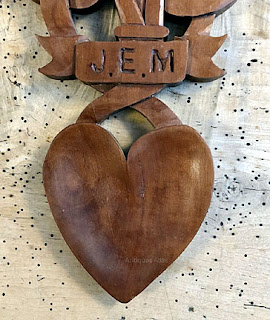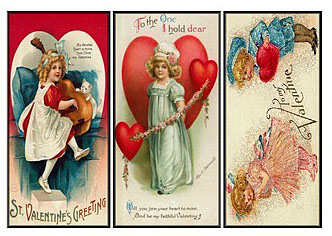 QUESTION: There are many ways of saying “I love you,” but one of the most unusual is the love spoon. I recently saw several of these in antique shops while traveling through Wales. About all the dealers could tell me about them was that they were gifts of love from a suitor to his true love, a tradition that has existed in Wales for several centuries. I bought one to take home, even though it seemed to be overly priced. What can you tell me about Welsh love spoons?
QUESTION: There are many ways of saying “I love you,” but one of the most unusual is the love spoon. I recently saw several of these in antique shops while traveling through Wales. About all the dealers could tell me about them was that they were gifts of love from a suitor to his true love, a tradition that has existed in Wales for several centuries. I bought one to take home, even though it seemed to be overly priced. What can you tell me about Welsh love spoons?
ANSWER: Rural lovers with their hearts set on a plain milkmaid would probably have been unable to buy a loving gift for Valentine’s Day back in the in the late 18th and 19th centuries. So they fashioned tokens of their love from whatever was close at hand, using whatever skills they had. Often these gifts might have been small personal items, such as knitting sheathes, stay busks and lace bobbins. But the gift that seemed to have stirred young girls’ hearts the most was the Welsh love spoon.
 No one knows why the Welsh made these love spoons. However, there was an earlier tradition among Scandinavians of giving love spoons. However, today most people associate the love spoon with the Welsh.
No one knows why the Welsh made these love spoons. However, there was an earlier tradition among Scandinavians of giving love spoons. However, today most people associate the love spoon with the Welsh.
So why give a spoon? For centuries the humble spoon was one of the most familiar of household utensils. The practice of storing spoons fitting snugly together prompted people to give a romantic meaning to the word in the 18th century. The delightfully descriptive word “spoonways” eventually embraced the human desire to emulate the closeness of these spoons in bed. The Victorians went further and used the verb “to spoon” to describe courting. In fact, the phrase continued in use well into the 20th century with popular song writers who found it a useful for its ability to rhyme with words such words as moon, June, swoon, and honeymoon.
It’s difficult to be precise about the origins of love spoons. However, enough of them inscribed with a date survive to enable collectors to trace their styles. One of the earliest recorded dates to 1667.
 Most of the spoons on the market today date from the late 18th and 19th centuries. Although generations of spoon carvers would have copied styles and designs, dating them is difficult. Those spoons with a broad, flat pierced handle seem to come predominantly from North Wales, while those that display clumsy carving and a lack of proportion tend to come from Pembrokeshire. The lucky young girl who received one really didn’t care where it came from.
Most of the spoons on the market today date from the late 18th and 19th centuries. Although generations of spoon carvers would have copied styles and designs, dating them is difficult. Those spoons with a broad, flat pierced handle seem to come predominantly from North Wales, while those that display clumsy carving and a lack of proportion tend to come from Pembrokeshire. The lucky young girl who received one really didn’t care where it came from.
What’s certain is that such prized possessions would have been displayed in a place of honor and no doubt the most eligible girls could acquire a small collection of these spoons before choosing their mates. The. infinite variety of styles and designs found in Welsh love spoons means that there are no two alike. Their great charm rests in what they represent and the symbolism in the motifs that carvers used to create them.
 The most common of these motifs was naturally the heart. Two hearts intertwined contained even more obvious meaning. Closely associated with the heart, and almost as common, was a motif that looked like a fat comma. This symbol comes from the ancient Egyptians sign for the soul. Thus, hearts and commas declare heart and soul. Keyholes represent another powerful motif, offering a way into the suitor's heart. And even other spoons feature a small muse, and occasionally a key that really helped make the suitor’s feelings known.
The most common of these motifs was naturally the heart. Two hearts intertwined contained even more obvious meaning. Closely associated with the heart, and almost as common, was a motif that looked like a fat comma. This symbol comes from the ancient Egyptians sign for the soul. Thus, hearts and commas declare heart and soul. Keyholes represent another powerful motif, offering a way into the suitor's heart. And even other spoons feature a small muse, and occasionally a key that really helped make the suitor’s feelings known.
Still, the formalities had to be observed and many love spoons incorporate chains—not simply to demonstrate the skill of the carver—but to indicate the chains that bind a marriage. Shoes and boots also appear frequently on love spoons. The origin of this motif is a reference in the Bible in which the exchange of a shoe signified agreement of a marriage contract.
 Carvers often incorporated initials with or without dates, and sometimes created spoons with a deeper, oblong window cutout into which a suitor inserted a piece of paper inscribed with names, dates, or drawings. Likewise, carvers sometimes added shards of broken mirrors. Why they did this is unclear. Perhaps it was to add a note of brightness to their spoon design, for none of these shards was large enough to serve as a looking glass.
Carvers often incorporated initials with or without dates, and sometimes created spoons with a deeper, oblong window cutout into which a suitor inserted a piece of paper inscribed with names, dates, or drawings. Likewise, carvers sometimes added shards of broken mirrors. Why they did this is unclear. Perhaps it was to add a note of brightness to their spoon design, for none of these shards was large enough to serve as a looking glass.
And while they used the most accessible and workable materials to carve their spoons, carvers used a variety of woods, especially easily carved sycamore and fruitwood.
 Occasionally, they created spoons from more exotic woods and materials, such as mahogany, ivory, or whalebone. This suggests that a sailor could have carved the spoon while on a voyage to a distant land. Sailors also seemed more likely to have embellished their spoons with inlaid colored wax or tiny brass pins. Some went even further and incorporated a lantern or cage containing free-moving balls into the handles, showing off the skill of the carver.
Occasionally, they created spoons from more exotic woods and materials, such as mahogany, ivory, or whalebone. This suggests that a sailor could have carved the spoon while on a voyage to a distant land. Sailors also seemed more likely to have embellished their spoons with inlaid colored wax or tiny brass pins. Some went even further and incorporated a lantern or cage containing free-moving balls into the handles, showing off the skill of the carver.
 The skill of some of these spoon makers was extraordinary, with the manual dexterity to produce even the most basic spoons. It’s also possible that an especially talented spoon carver could have made spoons for others in his area, accounting for the similarity of designs in spoons from certain places.
The skill of some of these spoon makers was extraordinary, with the manual dexterity to produce even the most basic spoons. It’s also possible that an especially talented spoon carver could have made spoons for others in his area, accounting for the similarity of designs in spoons from certain places.
Because love spoons now fetch higher prices both in the United Kingdom, the United States and Canada, it would be easy to give them an importance beyond their humble origins. Essentially, love spoons were simply a declaration of love, pure and simple.
To read more articles on antiques, please visit the Antiques Articles section of my Web site. And to stay up to the minute on antiques and collectibles, please join the over 30,000 readers by following my free online magazine, #TheAntiquesAlmanac. Learn more about old-time winter objects in the 2022/2023 Winter Holiday Edition, with the theme "Winter Memories," online now. And to read daily posts about unique objects from the past and their histories, like the #Antiques and More Collection on Facebook.



















